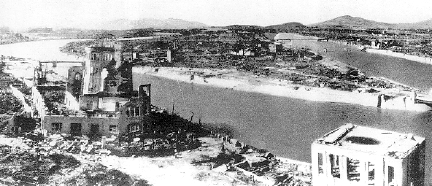
- Nuclear material was Uranium 235.
- Energy released was equivalent to 12.5 kilotons of TNT dynamite.
- Maximum temperature at burst point was several million degrees centigrade.
- A fireball of 30 meters diameter formed in 0.1 millisecond, with a temperature of 300,000 degrees centigrade and expanded to its maximum size in one second.
- The top of the atomic cloud reached an altitude of 17,000 meters.
- Radioactive debris was deposited by "black rain" that fell heavily for an hour over a wide area.
- Maximum wind pressure of the blast: 35 tons per square meter.
- Maximum wind velocity: 440 meters per second.
- Wooden houses within 2.3 kilometers of ground zero collapsed.
- Concrete buildings near ground zero hit by the blast from above had ceilings crushed and windows and doors blown off.
- Many people were trapped under fallen structures and burned to death.
- People exposed within 500 meters of ground zero were killed by the radiation.
- People exposed at distances of 3 to 5 kilometers later showed radiation symptoms, including radiation-induced cancers.
- More than 100,000 people died in the atomic explosions at Hiroshima and Nagasaki.
May 25, 2002 Washington, D. C. - The terms "suitcase nukes" and "dirty bombs" do not refer to the same radioactive weapon. A suitcase nuke in the 21st Century is about the size of the atom bomb the United States dropped on Hiroshima and Nagasaki in 1945 that ended World War II. Bomb making technology advanced so much during the Cold War with the Soviet Union that scientists were making similar bombs as small as suitcases, hence the name. Building atomic bombs, small or large, is not easy and the only country thought to have such weapons is Russia. But no one knows for certain where suitcase nukes might be or if any have been sold to countries such as Iran or Iraq.
Click here to subscribe and get instant access to read this report.
Click here to check your existing subscription status.
Existing members, login below:
© 1998 - 2025 by Linda Moulton Howe.
All Rights Reserved.

